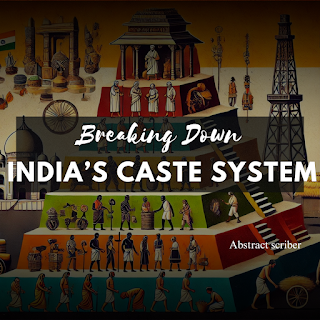Understanding Caste Hierarchy in India: Insights Into Social Stratification
 |
| Abstract Scriber |
Who created India's caste system ?
- Brahmins: Priests, scholars, and teachers, tasked with preserving and interpreting sacred texts.
- Kshatriyas: Warriors and rulers responsible for governance and protection.
- Vaishyas: Merchants, traders, and agriculturalists who managed commerce and agriculture.
- Shudras: Laborers and service providers tasked with supporting the other three classes.
What types of caste systems exist in India?
- Hierarchy: The system places castes in a strict ranking, with Brahmins at the top and Shudras at the bottom. Dalits, often referred to as "untouchables," were considered outside the caste system altogether and faced severe discrimination.
- Endogamy: Marriage was strictly restricted within one's caste, preserving the boundaries and reinforcing caste identity.
- Hereditary Occupations: Caste determined one’s profession, often leaving individuals with little to no opportunity for occupational mobility.
- Social Restrictions: Interaction between castes was heavily regulated, including rules about dining, socializing, and even physical proximity.
- Exclusion: Those considered “untouchable” were ostracized, prohibited from accessing temples, schools, and public spaces, and forced into menial jobs.
Caste in Colonial India
Does india still practice the caste system ?
- Reservation System: Quotas in education, employment, and politics for Scheduled Castes (SCs), Scheduled Tribes (STs), and Other Backward Classes (OBCs).
- Economic Assistance: Programs aimed at uplifting marginalized communities through financial aid and skill development.
- Social Inclusion: Campaigns and initiatives promoting equality and reducing caste-based prejudices.
Does India still have a caste system ?
Despite legal reforms, the caste system continues to influence various aspects of life in India. Some of the key challenges include:- Social Segregation: Caste-based discrimination, while illegal, persists, especially in rural areas. Practices such as separate wells, dining arrangements, and temple entry restrictions for lower castes still occur in some parts of India.
- Economic Disparities: Historical exclusion from education and land ownership has left lower castes economically disadvantaged. Many still struggle to access opportunities for upward mobility.
- Political Exploitation: Caste identities are often exploited during elections, with politicians appealing to caste-based vote banks rather than addressing broader social issues.
- Urban vs. Rural Divide: While urban areas show signs of caste becoming less relevant, rural areas continue to witness deep-seated caste dynamics.
- Violence and Oppression: Cases of violence against Dalits, including atrocities such as honor killings and denial of basic rights, highlight the persistence of caste-based oppression.
Social Reform Movements
- Dr. B.R. Ambedkar: A key figure in the fight against caste discrimination, Ambedkar championed the rights of Dalits and converted to Buddhism, inspiring millions to do the same.
- Mahatma Gandhi: Advocated for the upliftment of Dalits, whom he called Harijans (children of God), though his approach has faced criticism for being paternalistic.
- Jyotirao Phule and Savitribai Phule: Early reformers who fought for the rights of lower castes and women through education and social activism.
Why the caste system is still practiced today global ?
- Cultural Traditions: Deeply ingrained in Indian culture and other societies with historical connections to the caste system.
- Historical Practices: Long-standing social structures that continue to influence communities.
- Social Conditioning: Generational transmission of caste identities and beliefs.
- Economic Disparities: Limited access to resources and opportunities for lower castes perpetuates inequality.
- Lack of Awareness: Insufficient education and awareness about caste-based discrimination sustain its practice.
- Social Exclusion: Caste-based segregation and discrimination persist in daily life, particularly in rural areas.
How did the caste system affect indian society ?
-
Social Segregation: The caste system created rigid social divisions, restricting interactions and opportunities for lower castes, particularly Dalits, who faced discrimination and exclusion.
-
Economic Inequality: Higher castes had access to education and better job opportunities, while lower castes were confined to manual labor, perpetuating cycles of poverty.
-
Cultural and Religious Restrictions: The system was embedded in religion, limiting participation in social and religious activities for lower castes and reinforcing traditional roles.
-
Political Disempowerment: Political power was concentrated in higher castes, leaving lower castes with limited influence and access to resources.
-
Ongoing Impact: Though reforms have been made, the caste system's legacy still affects education, social dynamics, and economic opportunities in modern India.
How did the caste system affect the economy of india ?
- Rigid Division of Labor: The caste system confined individuals to hereditary occupations, limiting workforce mobility and stifling economic growth.
- Restricted Access to Resources: Lower castes, especially Dalits, faced barriers to land ownership, capital, and education, preventing economic advancement.
- Economic Inequality: Higher castes accumulated wealth through administrative and religious roles, while lower castes were relegated to labor-intensive tasks with little financial reward.
- Underutilized Talent: Caste-based restrictions prevented many individuals from pursuing opportunities based on talent and skill, limiting innovation and economic development.
- Legacy of Disparities: Despite abolition, caste-based economic inequalities persist in modern India, affecting education, employment, and entrepreneurship.
A Path Forward
Even though India has made great progress in addressing caste-based inequality, more has to be done.- Education: Raising awareness of caste discrimination's negative impacts and equality.
- Economic Empowerment: Ensuring equal access to education, employment, and resources for marginalized communities.
- Legislative Enforcement: Strengthening the implementation of laws against caste discrimination and addressing systemic biases.
- Social Integration: Encouraging inter-caste marriages, inclusive practices, and dialogue to break traditional barriers.



Comments
Post a Comment